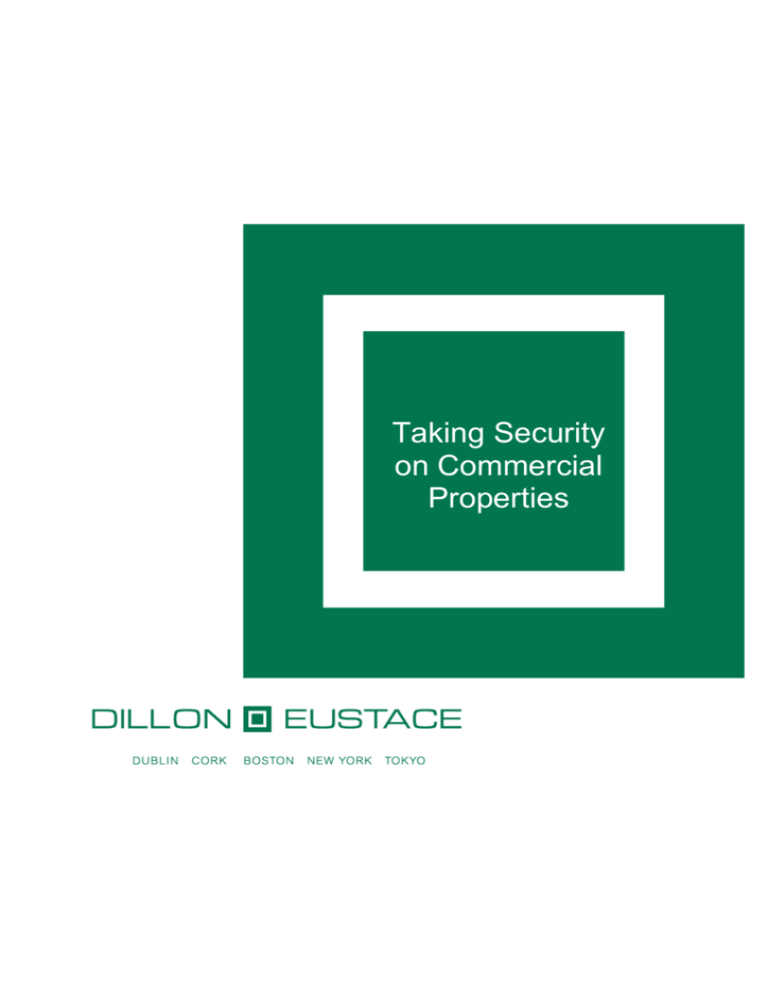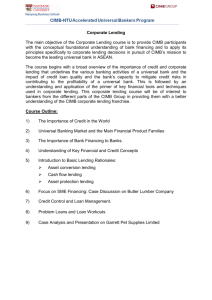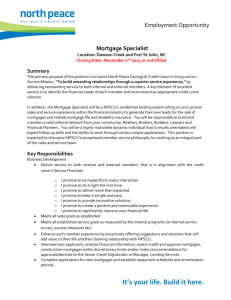
Taking Security
on Commercial
Properties
0
TAKING SECURITY ON COMMERCIAL PROPERTIES
Introduction
The purpose of a bank or other lending institution taking security over commercial property is
to ensure a quicker and more assured payout in the event that a borrower company goes
into receivership, examinership or liquidation.
In this regard, there are different types of security which the lending institution may put in
place in order to safeguard its investment.
Before detailing the various methods of taking security, the difference between a fixed
charge and a floating charge should be explained. A fixed charge is security over a particular
asset. Conversely, a floating charge constitutes a charge over all assets of the borrower
company as acquired from time to time. The company remains free to deal with its assets in
the ordinary course of business. The charge only becomes a fixed charge upon
crystallisation. Crystallisation occurs on the appointment of a receiver or liquidator and the
floating charge fixes on all assets in the ownership of the company at that time.
A fixed charge gives the best position to a lending institution as regards any consequences
of enforcement1. The main disadvantage with a floating charge is that preferential creditors
such as the revenue commissioners rank in priority to the floating charge, but after the fixed
charge.
Unless the lending institution lodges a notice of the fixed or floating charge created by a
company within 21 days of its creation with the Companies Office, the charge will be void
against the liquidator or any creditor of the company. Accordingly, it is essential to ensure
that a Companies Registration Office (“CRO”) Form C1 is completed by the borrowing
company on the occasion of completing the loan transaction and the Form C1 is filed with
the CRO as quickly as possible after the completion of the transaction and, in any event,
within 21 days.
1
The priority on insolvency as set by Section 285 and 98 of the Companies Act, 1963, as
amended.
1
Debenture
A debenture is a document which contains a covenant by a company to pay all sums due or
to become due by the company to the lending institution and which contains a charge (fixed
and/or floating in favour of the lending institution).
Mortgage
A legal mortgage is commonly understood to be a ‘conditional transfer’ of a property to a
lending institution that may become absolute if the mortgagor falls into arrears and is unable
to make the repayments which it covenants to make.
An equitable mortgage passes only an equitable estate or interest, either because the form
of transfer or conveyance used is an equitable one (i.e. operates only as between the parties
to it and those who have notice of it, such as an equitable mortgage by deposit of title
deeds), or because the mortgagor’s estate or interest is equitable (i.e. it consists merely of
the right to obtain a conveyance of the legal estate).
The main disadvantage with an equitable mortgage is that it is not as secure as a legal
mortgage, primarily because it is not usually registered in the Land Registry or Registry of
Deeds. Accordingly, legal mortgages, which have been registered, will gain priority over
equitable mortgages.
Charge
A charge is the form of security for the repayment of a debt or performance of an obligation
consisting of the right of the lending institution to receive payment out of some specific fund
or out of the proceeds of the realisation of specific property.
There is a difference between ‘mortgaging’ a property, title to which has been registered in
the Land Registry, and ‘mortgaging’ an unregistered property. In fact, a Registry of Deeds
property is mortgaged and a Land Registry property is charged.
The distinction is that unregistered property (i.e. property with a Registry of Deeds title) is
conveyed, leased or assigned by the borrower to the lending institution (subject to the
borrower’s equity of redemption in the property). The equity of redemption describes the
rights retained by the borrower in relation to the property and includes the borrower’s
equitable right to get the title back and have it vested in him once more when the loan is
repaid.
2
Registered land (i.e. property with a Land Registry title) may be ‘mortgaged’ only by the
registered owner by means of a registered charge. Unlike a mortgage, a charge involves no
transfer of ownership to the lending institution. Ownership remains with the registered owner
and the lending institution only acquires rights over the property.
Pledge
A pledge arises where documents of title for a property are delivered by the pledgor to the
pledgee to be held as security for the payment of a debt or for the discharge of some other
obligation. The subject matter of the pledge will be restored to the pledgor as soon as the
debt is discharged. Where a definite time for payment has been fixed, the pledgee has an
implied power of sale upon default.
The difference between a pledge and a mortgage is that a pledgor of property only has a
‘special title’ to the property, while a mortgagee has an absolute title to the property subject
to the right of redemption. A further distinction between a pledge and a mortgage is that a
pledgee (unlike a mortgagee) cannot obtain foreclosure but has a right to sell the property.
Priority of Security
As stated above, the fundamental reason for a credit institution taking security is to
safeguard its investment and to ensure a faster payout should the borrower company go into
receivership or liquidation. Accordingly, priority of security is an essential consideration in
circumstances where more than one lending institution advances secured facilities to a
borrower. Priority of security refers to the order in which the lending institution shall rank for
payment on a distribution of the borrower’s property, which is subject to the lending
institution’s security.
Endnotes
The Priority on insolvency as set by Section 285 and 98 of the Companies Act 1963, as
amended, is as follows:
creditors secured by a fixed charge;
preferential creditors (e.g. certain taxes, rates, redundancy payments);
creditors secured by a floating charge; and
ordinary creditors.
Date:
Author:
September, 2007
Linda Lynch
3
CONTACT US
Our Offices
Dublin
33 Sir John Rogerson’s Quay,
Dublin 2,
Ireland.
Tel: +353 1 667 0022
Fax.: +353 1 667 0042
Contact Points
Cork
For more details on how we can help
you, to request copies of most recent
newsletters, briefings or articles, or
simply to be included on our mailing
list going forward, please contact any
of the team members below.
8 Webworks Cork,
Eglinton Street,
Cork, Ireland.
Tel: +353 21 425 0630
Fax: +353 21 425 0632
Paul Eustace
e-mail: paul.eustace@dilloneustace.ie
Tel : +353 1 667 0022
Fax: + 353 1 667 0042
Boston
26th Floor,
225 Franklin Street,
Boston, MA 02110,
United States of America.
Tel: +1 617 217 2866
Fax: +1 617 217 2566
New York
245 Park Avenue
39th Floor
New York, NY 10167
United States
Tel: +1 212 792 4166
Fax: +1 212 792 4167
DISCLAIMER:
This document is for information purposes only and
does not purport to represent legal advice. If you
have any queries or would like further information
relating to any of the above matters, please refer to
the contacts above or your usual contact in Dillon
Eustace.
Copyright Notice:
© 2009 Dillon Eustace. All rights reserved.
This article was first published on
www.internationallawoffice.com - the Official Online
Media Partner to the International Bar Association,
an International Online Media Partner to the
Association of Corporate Counsel and European
Online Media Partner to the European Company
Lawyers Association. Register for a free subscription
at www.internationallawoffice.com/subscribe.cfm
Tokyo
12th Floor,
Yurakucho Itocia Building
2-7-1 Yurakucho, Chiyoda-ku
Tokyo 100-0006, Japan
Tel: +813 6860 4885
Fax: +813 6860 4501
e-mail: enquiries@dilloneustace.ie
website: www.dilloneustace.ie
0
1








